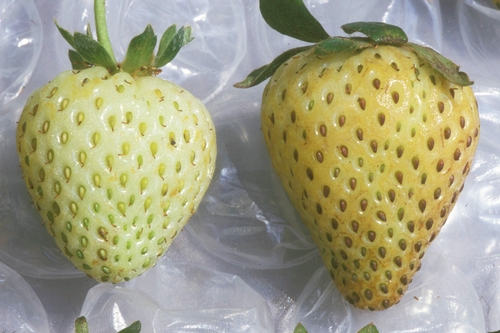Strawberry Fruit Bronzing Occurring on Coast
by Steven Koike
UC Cooperative Extension
Starting around mid-May and extending into June, strawberry growers and pest control advisors in coastal California are observing the fruit problem known as bronzing. This problem occurs every year to some extent but can result in large economic losses in some seasons. Bronzing results in a tan or bronzed discoloration on green and ripening strawberry fruit. Bronzed fruit have dried, rough surfaces that render the fruit unmarketable (Photos 1 and 2). The skin of such fruit can later crack.
There are three types of bronzing. Type I bronzing occurs on distinct, localized parts of the fruit, often beneath the fruit calyx or around the strawberry seeds (achenes), and is caused by insect feeding, primarily thrips (physical damage due to abrasion (Photo 3) is also very localized). Type II bronzing is caused by chemical sprays that cause a one-sided bronzing to the side of the fruit exposed to the application. In contrast, Type III bronzing covers virtually the entire surface of the fruit, occurs during certain periods of time, and can result in devastating crop loss. It is notable that Type III bronzing in coastal California tends to occur when the weather is sunny and warm.
Field-based research has demonstrated that Type III bronzing is associated with fruit exposure to stressful environmental conditions that include extreme solar radiation, high temperatures, and low relative humidity. This Type III problem is not caused by sulfur applications or feeding by thrips, mites, or other pests.
The problem is difficult to manage and prevent. Strawberry cultivars differ in their susceptibility to Type III bronzing, so growers should consider this factor when selecting cultivars for planting. Growing the strawberry crop so as to reduce physiological stress to the plants is a general overall recommendation. Observant growers and PCAs noted that commercial fields that happened to receive insecticide or fungicide sprays prior to a high temperature, high-sunlight intensity bronzing period had in many cases significantly lower bronzing losses compared to adjacent untreated fields. This situation likely occurred because commercial pesticides usually contain additives that protect the products from solar and ultraviolet radiation; such sprays also provided similar protection to the strawberry fruit.

Photo Courtesy Steven Koike, UCCE

Photo courtesy Steven Koike, UCCE

Photo Courtesy Steven Koike, UCCE


Posted by Klaas Plas on June 29, 2010 at 9:23 AM